“I am […] taking a series of photos of the Acropolis;
not only picturesque, but to show the technical characteristics
of Greek architecture.”
William James Stillman (1828-1901)
The invention of the Daguerreotype, the first photographic technology, came within a decade of Greek independence in 1830. Soon thereafter the picturesque sites of Greece attracted some of the very first photographers. Most of them focused their lenses on Athens, primarily on the Acropolis, and most specifically on the Parthenon, a structure often regarded as the incarnation of classical perfection.
The earliest known photograph of the Parthenon, from late 1839, shows the small mosque that had been constructed inside the ruin of the temple. As a post-antique structure closely associated with the Ottoman occupation, it was removed shortly thereafter. Early photographs constitute the only evidence for the appearance of this and many other structures since removed from the Acropolis.
The images on view here show ancient ruins in Asia Minor, Athens, and the Acropolis. Photographers from France, Italy, Turkey, Scotland, and the United States disseminated images of the classical ruins to a large international audience. One of the photographs, taken at the British Museum in London, shows sculptures that Lord Elgin had removed from the Acropolis at the beginning of the 19th century, a removal that triggered a demand for their return that is ongoing to this day.
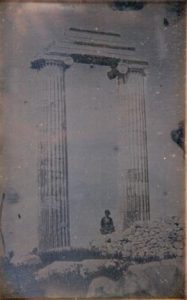
(NA)
Joseph-Philibert Girault de Prangey (French, 1804–1892)
76. Jéronda. Temple—Colonnes. [Didyma], c. 1843
Daguerreotype
Purchase with funds provided by the Christian A. Johnson Memorial Art Acquisition Fund
2004.034
Trained initially as a painter, Joseph-Philibert Girault de Prangey learned about daguerreotypes in 1839 and by 1841 had mastered the new medium. In 1842 he set out on a three-year trip to Italy, Greece, Turkey, Palestine, and Egypt. He was one of the first photographers to capture classical ruins. In 1842 he made the earliest surviving photograph of the Parthenon in Athens.
Taken in 1843, this photograph depicts—in mirror image—the Ionic columns and entablature of the large Hellenistic Temple of Apollo at Didyma in Asia Minor. Girault de Prangey shot the columns from the northwest, possibly to conceal the windmill that stood atop the ruins. The inclusion of the figure effectively provides a sense of scale to the columns captured in this small image. It is one of four images Girault de Prangey took at Didyma, the earliest surviving photographs of the site.

(PR) (AN)
Eugéne Piot (French, 1812–1890)
Les Propylées: Vue prise du Rocher de l’Aréopage [The Propylaia: View taken from the Aeropagus]
From the portfolio L’Acropole d’Athène [The Acropolis of Athens], 1852
Salt print from waxed paper negative
Gift (by exchange) of Wilson Farnsworth, George Mead, and Henry Sheldon
2015.222
Eugène Piot, a French lawyer and art dealer, turned to photography in the early 1840s. He traveled to Greece in 1852, where he was interested not only in the classical antiquities but also in the Byzantine, Frankish, and Ottoman remains.
This salt print, part of a set of images of the Acropolis that was reproduced and sold as a portfolio, shows the western end of the Acropolis, with the so-called “Frankish Tower” as its main focus. That structure was built around 1400 by the Acciaioli family, the Florentine rulers of the Duchy of Athens. It was demolished in 1875 with funds provided by the German archaeologist Heinrich Schliemann.
Were it not for the Temple of Athena Nike that is partially visible to the right of the tower, this imposing view would hardly be recognizable as the Athenian Acropolis.
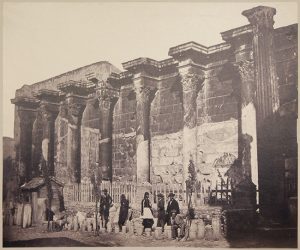
(NA)
James Robertson (Scottish, 1813–1888) and Felice Beato (British, born in Italy, 1832–1909)
The Library of Hadrian, 1853/4 or 1856
Albumen print from a wet collodion negative
10 x 12 inches (image)
Gift (by exchange) of Wilson Farnsworth, George Mead, and Henry Sheldon
2015.223
In the early 1850s, while employed as a die maker and engraver at the Imperial Ottoman Mint in Istanbul, James Robertson set up the first photography studio in the Ottoman Empire. Robertson made a photographic expedition to Greece in 1853/4 and returned there with his partner and brother-in-law Felice Beato in 1856.
This print shows the west facade of the Library of Hadrian in Athens, built in 132 CE just north of the Acropolis. Like Augustus before him, the Roman emperor Hadrian wanted to associate himself with Pericles, although the library’s richly textured facade is more Hellenistic than High Classical in style.
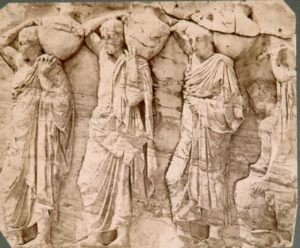
(PA)
Dimitrios Konstantinou (Greek, active 1850s–1860s)
Slab of the North Frieze of the Parthenon in Athens, c. 1860
Albumen print
Gift of an Anonymous Donor
2004.037
In 1850 Dimitrios Konstantinou established the second photography studio in Greece. He had been associated with Robertson and Beato during their visit to Greece some years prior. Later Konstantinou became the first photographer to work for the Greek Archaeological Service.
This print was cropped to conform to the shape of the sculptural slab it depicts. The relief features the hydriaphoroi, water carriers, and comes from the north frieze of the Parthenon. The aloof and idealized figures are typical of the so-called “Parthenon Style.”
On the right side of the slab, just barely visible, is the brick lining of the interior of the north wall of the Parthenon, an intervention dating to the 1840s. The slab, alongside several others, was placed there by Kyriakos Pittakis (Greek, 1798–1863) who converted the Periclean monuments into sculptural displays sometime between 1856 and 1860.
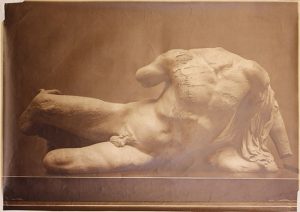
(PA)
Adolphe Braun (French, 1812–1877)
Sculptural Fragment from the Parthenon in the British Museum, 1870s
Toned carbon print from wet collodion negative
Gift (by exchange) of Wilson Farnsworth, George Mead, and Henry Sheldon
2015.224
In the mid-1860s Adolphe Braun, an Alsatian photographer already known for his flower studies and Parisian street scenes, invested in a new method for making multiple prints. He used this carbon printing technique to produce large photographic reproductions of works of art in major museums like the Louvre in Paris, the Albertina in Vienna, and, as is the case here, the British Museum in London.
This photograph shows the river god Illissos, depicted as a reclining nude, from the west pediment of the Parthenon. The pediment sculptures have been attributed to Pheidias. Together with the other Elgin Marbles, this sculpture was removed from the Parthenon earlier in the century.
William James Stillman (American, 1828–1901)
Plates from The Acropolis of Athens Illustrated Picturesquely and Architecturally in Photography, London 1870
A spy, diplomat, journalist, critic, art historian, and painter, William Stillman led a tumultuous life that took him to the U.K., France, Switzerland, Hungary, Italy, Crete (then still part of the Ottoman Empire), and Greece. He learned about photography in Florida in 1858, while recovering from an illness. Three years later, in Rome, he bought a camera from a disillusioned itinerant photographer.
In 1869 Stillman was in Athens, working on a folio-sized volume of 25 views of the Acropolis. From the images it is clear that Stillman was fully aware of the photographic conventions that had developed over the past quarter century. Yet one can also see his own aesthetic principles applied: the notions of the picturesque as outlined by his mentor John Ruskin combined with a deliberate objectivity, described in his own words as “a photograph is nothing but a communication of fact.”

(PA)
Plate 15: Eastern portico of the Parthenon, view looking northward and showing Mount Parnes in the extreme distance.
Vintage carbon print
Gift (by exchange) of Wilson Farnsworth, George Mead, and Henry Sheldon
2015.027
This dramatic image with its deep perspective and sharp chiaroscuro was taken inside the east portico of the Parthenon. The focus is as much on the towering column centered in the composition, standing out against the landscape and sky, as it is on the figure in Western dress, very likely Stillman himself, providing a reference of scale to the architecture.
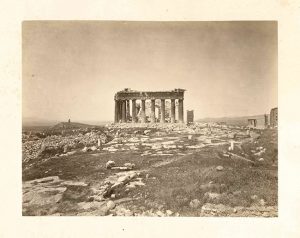
(PA)
Plate 18: General view of the summit of the Acropolis, from the extreme eastern point, showing the Erechtheum at the right, and in the distance, at the left, the Egean [sic]. The Parthenon occupies the centre.
Albumen print
Gift (by exchange) of Wilson Farnsworth, George Mead, and Henry Sheldon
2015.025
By placing his camera far from the Parthenon, Stillman accentuates the stark landscape of the Acropolis with its Athenian sky framing the landmark structure. Stillman moved his camera to the right of the temple’s temple’s axis, probably to include the Frankish Tower at the Propylaia, a post-antique structure. On the right of the image the Erechtheion’s Caryatid Porch is visible.

(ER)
Plate 19: The eastern facade of the Erechtheum
Vintage carbon print
Gift (by exchange) of Wilson Farnsworth, George Mead, and Henry Sheldon
2015.026
“The facades, as far as practicable, [are] photographed from points exactly equidistant from the extremities,” Stillman wrote in the preface to the plates. In this view, the east facade of the Erechtheion is captured almost on axis. As a result, the slender Ionic columns and entablature are silhouetted against the sky, visually buttressed by the Caryatid Porch and the North Portico of the temple. This arresting arrangement is framed, in turn, by the Frankish Tower and the last remains of the post-antique fortifications.

